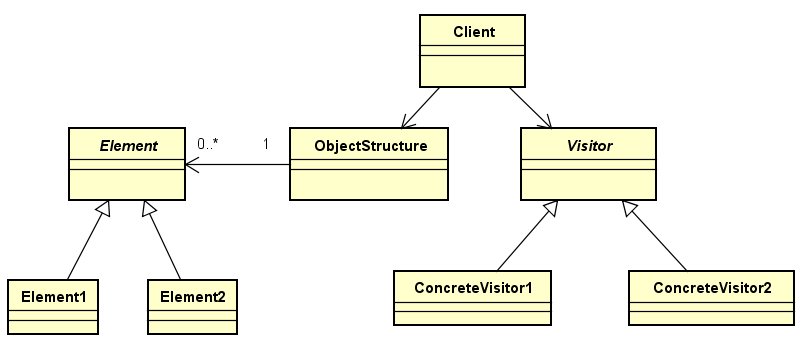Amy(PO):
As a 電商老闆
I want 舉辦行銷活動,購物車結帳時:
- 書籍雜誌:會員相同類別10本以上八折優惠
- 生活用品:會員相同品項$1,000以上九折優惠
So that 提高網站轉換率及營收
JB:
這個需求看起來很簡單,但是仔細想了一下,發現要寫好程式很困難耶! 我們得考慮:
Lily:
你說的沒錯,唯一不變的就是"變"。
所以我們得把這些折扣的算法轉換成策略模式(Strategy);這個可以解決第一個問題。
第二個問題,我們得把相同優惠策略的商品放在一個抽象的容器,結帳時,把在相同集合的不同商品採用一樣的優惠策略計算最後的價錢,未來如果有其他商品需要用到現成的優惠,就可以把它也丟到這個抽象的容器即可!
JB:
聽起來好像將某一個容器裡面的所有元素,讓他們跑同一個策略?
Lily:
沒錯! 這種行為(Behavioral design patterns)叫做Visitor訪問者模式!
表示要在結構裡面的元素執行的操作。訪問者(Visitor)可以讓你定義一個新的操作讓這些元素使用,而不用改變元素類別。 (WIKI)
簡單的來說! 訪問者模式(Visitor)是策略模式(Strategy)的延伸。
在策略模式中,我們只讓一個對象執行注入的策略。
但在訪問者模式,我們可以讓很多對象依序執行注入的策略。
先有這個概念之後,我們來看例子,最後再討論兩者使用的時機。

我們在這個行銷活動,要建立兩個商品計算折扣後價格的策略,分別為:
PS. 建立Visitor時只考慮計算的公式,而先不考慮它適用於哪些商品。
public abstract class Visitor
{
public abstract void Visit(IElement element);
}
/// 該項商品數量10以上八折優惠
public class VisitorDiscount4Count : Visitor
{
public override void Visit(IElement elm)
{
if(elm.Amount>=10)
{
elm.TotalPrice = elm.UnitPrice * elm.Amount * 0.8M;
Trace.WriteLine($"(折扣!){elm.Name}: 單價${elm.UnitPrice}, 數量{elm.Amount}, 20% off, 總價格={elm.TotalPrice} ");
}
else
{
elm.TotalPrice = elm.UnitPrice * elm.Amount;
Trace.WriteLine($"{elm.Name}: 單價${elm.UnitPrice}, 數量{elm.Amount}, 總價格={elm.TotalPrice} ");
}
}
}
/// 該項商品總價$1,000以上九折優惠
public class VisitorDiscount4TotalPrice : Visitor
{
public override void Visit(IElement elm)
{
var totalPrice =elm.UnitPrice * (decimal)elm.Amount;
if(totalPrice>1000)
{
elm.TotalPrice = totalPrice * 0.9M;
Trace.WriteLine($"(折扣!){elm.Name}: 單價${elm.UnitPrice}, 數量{elm.Amount}, 10% off, 總價格={elm.TotalPrice} ");
}
else
{
elm.TotalPrice = totalPrice;
Trace.WriteLine($"{elm.Name}: 單價${elm.UnitPrice}, 數量{elm.Amount}, 總價格={elm.TotalPrice} ");
}
}
}
from abc import ABC, abstractmethod
from decimal import Decimal
class Visitor(ABC):
@abstractmethod
def visit(self, element=Elements.Element):
pass
class VisitorDiscount4Count(Visitor):
"""該項商品數量10以上八折優惠"""
def visit(self, elm=Elements.Element):
if(elm.amount >= 10):
elm.totalPrice = elm.unitPrice * Decimal(elm.amount) * Decimal(0.8)
print("(折扣!){0}: 單價${1}, 數量{2}, 20% off, 總價格={3}".format(
elm.name, elm.unitPrice, elm.amount, "{0:.2f}".format(elm.totalPrice)))
else:
elm.totalPrice = elm.unitPrice * Decimal(elm.amount)
print("{0}: 單價${1}, 數量{2}, 總價格={3}".format(
elm.name, elm.unitPrice, elm.amount, "{0:.2f}".format(elm.totalPrice)))
class VisitorDiscount4TotalPrice(Visitor):
"""該項商品總價$1,000以上九折優惠"""
def visit(self, elm=Elements.Element):
totalPrice = elm.unitPrice * Decimal(elm.amount)
if(totalPrice > 1000):
elm.totalPrice = Decimal(totalPrice) * Decimal(0.9)
print("(折扣!){0}: 單價${1}, 數量{2}, 10% off, 總價格={3}".format(
elm.name, elm.unitPrice, elm.amount, "{0:.2f}".format(elm.totalPrice)))
else:
elm.totalPrice = totalPrice
print("{0}: 單價${1}, 數量{2}, 總價格={3}".format(
elm.name, elm.unitPrice, elm.amount, "{0:.2f}".format(elm.totalPrice)))
在這個例子,Element很明顯的就是我們放在購物車的商品,
其屬性應包含商品名稱、種類、單價、數量以及我們要計算的總價格,以及一個可以讓Visitor執行訪問的方法:Accept。
public enum ProductTypeEnum
{
Book = 1, //書
Living, //生活用品
Electronic //電子用品
}
public interface IElement
{
ProductTypeEnum ProductType { get; set; }
string Name { get; set; }
decimal UnitPrice { get; set; } //單價
int Amount { get; set; } //購買總數
decimal TotalPrice { get; set; }
void Accept(Visitor visitor);
}
public class Product : IElement
{
public ProductTypeEnum ProductType { get; set; }
public string Name {get;set;}
public decimal UnitPrice { get;set; }
public int Amount { get; set; }
public decimal TotalPrice {get;set;}
public void Accept(Visitor visitor)
{
visitor.Visit(this);
}
}
from abc import ABC, abstractmethod
from enum import Enum
from decimal import Decimal
class ProductTypeEnum(Enum):
Book = 1, # 書
Living = 2, # 生活用品
Electronic = 3 # 電子用品
class Element(ABC):
def __init__(self, productType:ProductTypeEnum, name="", unitPrice=0, amount=0):
self.productType = productType
self.name = name
self.unitPrice = Decimal(unitPrice)
self.amount = amount
self.totalPrice=Decimal(0)
@abstractmethod
def accept(self, visitor):
pass
class Product(Element):
def __init__(self, productType=ProductTypeEnum, name="", unitPrice=0, amount=0):
super().__init__(productType, name, unitPrice, amount)
def accept(self, visitor):
visitor.visit(self)
到這邊已經完成了策略模式! 我們可以在主程式這樣使用它:(以C#為例)
IElement elm = new Product {
ProductType=ProductTypeEnum.Book, Name="設計模式的解析與活用", UnitPrice=480, Amount=20 };
elm.Accept(new VisitorDiscount4Count());
但是在訪問者模式,我們要利用ObjectStructure這個角色協助一次訪問多個元素。
ObjectStructure的作用:
public interface IObjectStructure
{
List<IElement> Elements { get; set; }
void Attach(IElement element);
void Detach(IElement element);
void Accept(Visitor visitor);
}
public class ObjectStructure : IObjectStructure
{
public List<IElement> Elements { get; set; }
public ObjectStructure()
{
this.Elements = new List<IElement>();
}
public void Attach(IElement element)
{
this.Elements.Add(element);
}
public void Detach(IElement element)
{
this.Elements.Remove(element);
}
public void Accept(Visitor visitor)
{
this.Elements.ForEach(x => x.Accept(visitor));
}
}
import Elements
import Visitors
class ObjectStructure:
def __init__(self):
self.elements = []
def attach(self,element: Elements.Element):
self.elements.append(element)
def detach(self,element: Elements.Element):
self.elements.remove(element)
def accept(self,visitor: Visitors.Visitor):
for elm in self.elements:
elm.accept(visitor)
我們來看這個購物車如何透過訪問者模式結帳:
private List<IElement> Shopcart = null;
this.Shopcart = new List<IElement>(){
new Product { ProductType=ProductTypeEnum.Book, Name="設計模式的解析與活用", UnitPrice=480, Amount=20 },
new Product { ProductType=ProductTypeEnum.Book, Name="使用者故事對照", UnitPrice=580, Amount=5 }
};
IObjectStructure checkout = new ObjectStructure();
//Attach the elements into ObjectStructure
this.Shopcart.Where(item=>item.ProductType.Equals(ProductTypeEnum.Book)).ToList().ForEach(item => {
checkout.Attach(item);
});
//Accept all the elements and execute the strategy from certain Visitor
checkout.Accept(new VisitorDiscount4Count());
以上針對購物車裡面的書籍,將其放入ObjectStructure,再統一使用VisitorDiscount4Count(該項商品數量10以上八折優惠)訪問。 執行結果:
(折扣!)設計模式的解析與活用: 單價$480, 數量20, 20% off, 總價格=7680.0
使用者故事對照: 單價$580, 數量5, 總價格=2900
_shopcart = [
Elements.Product(productType=Elements.ProductTypeEnum.Living,
name="吸塵器", unitPrice=2000, amount=2),
Elements.Product(productType=Elements.ProductTypeEnum.Living,
name="毛巾", unitPrice=50, amount=10)
]
checkout = ObjectStructure()
# Attach the elements into ObjectStructure
targetProds = [
x for x in self._shopcart if x.productType == Elements.ProductTypeEnum.Living]
for item in targetProds:
checkout.attach(item)
# Accept all the elements and execute the strategy from certain Visitor
checkout.accept(VisitorDiscount4TotalPrice())
以上針對購物車裡面的生活用品,將其放入ObjectStructure,再統一使用VisitorDiscount4TotalPrice(該項商品數該項商品總價$1,000以上九折優惠)訪問。 執行結果:
(折扣!)吸塵器: 單價$2000, 數量2, 10% off, 總價格=3600.00
毛巾: 單價$50, 數量10, 總價格=500.00
我們來看了解一下兩者的使用時機:
